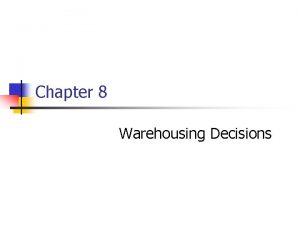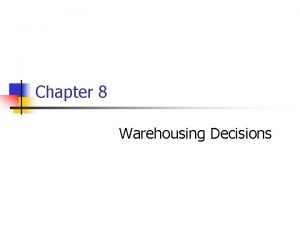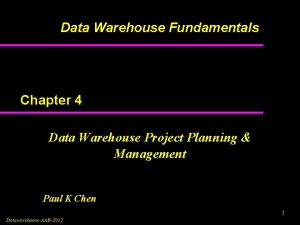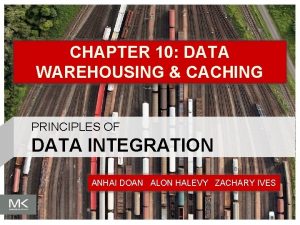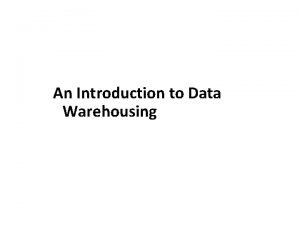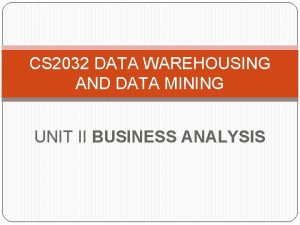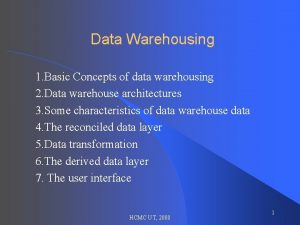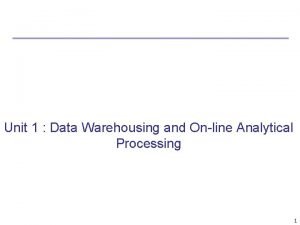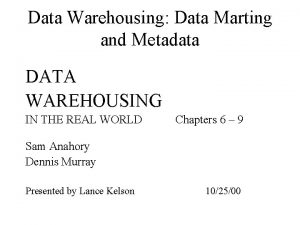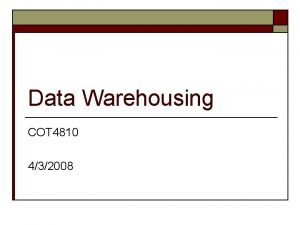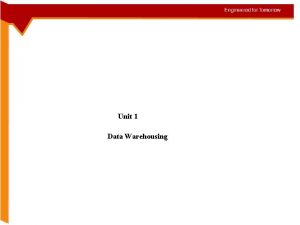Data Warehousing Data Warehousing Make the right decisions



















































- Slides: 51

Data Warehousing

Data Warehousing • Make the right decisions for your organization – Rapid access to all kinds of information – Research and analyze the past data – Identify and predict future trends • The construction of data warehouse – Involve data cleaning and data integration – Provide on-line analytical processing (OLAP) tools for the interactive analysis of data • W. H. Inmon – A data warehouse is a subject oriented, integrated, timedependent and non-volatile collection of data in support of management’s decision making process

Characteristics of Data Warehouse • Subject-oriented – Data warehouse is designed for decision support and around major subject, such as customer and sales – Not all information in the operational database is useful • Integrated – Integrate multiple heterogeneous sources and make it consistent – The data from different sources may use different names for the same entities

Characteristics of Data Warehouse • Time dependent – Record the information and the time when it was entered – Data mining can be done from the data in some period of time • Non-volatile – Data in a data warehouse is never updated

Data Warehousing • Data warehousing – The process of constructing and using data warehouse • Two types of databases – Operational database • Large database in operation • Built for high speed and large number of users – Data warehouse • Designed for decision support • Contain vast amounts of historical data • Data mart – A department subset of the data warehouse that focuses on selected subjects, and its scope is department-wide

OLTP & OLAP System • OLTP (On-Line Transaction Processing) System – The major task of operational database is to perform on-line transaction and query processing • OLAP (On-Line Analytical Processing) System – Data warehouse system serves users on data analysis and decision making

Differences ~ OLTP & OLAP • Characteristic – OLTP: operational processing – OLAP: informational processing • Orientation – OLTP: transaction-oriented – OLAP: analysis-oriented • User – OLTP: customer, DBA – OLAP: manager, analyst • Function – OLTP: day-to-day operations – OLAP: information requirement, decision support

Differences ~ OLTP & OLAP • DB design – OLTP: ER based, application-oriented – OLAP: star/snowflake, subject-oriented • Data – OLTP: current; guaranteed up-to date – OLAP: historical • Unit of work – OLTP: short, simple query – OLAP: complex query • Access – OLTP: read/write – OLAP: mostly read • DB size – OLTP: 100 MB to GM – OLAP: 100 GB to TB

Differences ~ OLTP & OLAP

Data Warehousing Relational Data Model Relational Schema Multidimensional Data Model Star Schema or Snowflake Schema

Model & Schema for Relational Database Relational Data Model Relational Schema

Multidimensional Data Model • Example: All. Electronics creates a sales data warehouse in order to keep records of the store’s sales – Fact Table • sales amount in dollars and number of units sold (measure) – Dimension Tables • time, item, branch, and location • Multidimensional data model views data in the form of a data cube

Two Dimensions • 2 -D view of sales data for item sold per quarter in the city of Vancouver. The measure is dollars_sold (in thousands) Dimensions Measures

Three Dimensions • 3 -D view of sales data according to the dimensions time, item and location. The measure is dollars_sold (in thousands) Dimensions Measures

Three Dimensions • 3 -D data cube representation according to the dimensions time, item and location. The measure is dollars_sold (in thousands)

Four Dimensions • 4 -D data cube of sales data according to the dimensions supplier, time, item and location. The measure is dollars_sold (in thousands)

Schemas for Multidimensional Data Model • Star Schema • Snowflake Schema • Fact Constellation Schema

Star Schema

Snowflake Schema

Snowflake Schema • Some dimension tables are normalized to reduce redundancies and save storage space • Reduce the effectiveness of browsing since more join will be needed to execute a query • This saving of space is negligible in comparison to the magnitude of the fact table • Snowflake schema is not as popular as the start schema in data warehouse design

Fact Constellation Schema • Multiple fact tables share dimension tables

OLAP Technologies

Concept Hierarchies



Three-Tier DW Architecture

Case Study in Data Warehousing





















Design of Data Warehouse • How can I design a data warehouse ? – Top-down approach – Bottom-up approach – Combination of both • In general, the warehouse design process consists of the following steps – – Choose a business process to model Choose the gain of the business process Choose the dimensions Choose the measures



 Image making meaning
Image making meaning Right product right place right time right price
Right product right place right time right price Family time
Family time To make place decisions marketers select the right
To make place decisions marketers select the right Chapter 13 marketing in today's world
Chapter 13 marketing in today's world Basic warehousing decisions
Basic warehousing decisions Nature and importance of warehousing
Nature and importance of warehousing The right man on the right place at the right time
The right man on the right place at the right time Screening decisions and preference decisions
Screening decisions and preference decisions What is data mining and data warehousing
What is data mining and data warehousing Hive provides data warehousing layer to data over hadoop
Hive provides data warehousing layer to data over hadoop Data warehousing and data mining in crm
Data warehousing and data mining in crm Olap in data mining
Olap in data mining Data warehouse modeling best practices
Data warehouse modeling best practices Introduction to data mining and data warehousing
Introduction to data mining and data warehousing Political savvy pdf
Political savvy pdf Typical marketing channels for consumer products
Typical marketing channels for consumer products Multiple distribution channel
Multiple distribution channel Haudenosaunee anishinabe mi'kmaq
Haudenosaunee anishinabe mi'kmaq Informational data store in data warehouse
Informational data store in data warehouse Greenplum data warehousing
Greenplum data warehousing Data warehousing components
Data warehousing components Data warehouse project plan
Data warehouse project plan 1keydata data warehousing
1keydata data warehousing Data warehousing principles
Data warehousing principles An overview of data warehousing and olap technology
An overview of data warehousing and olap technology Introduction to data warehouse
Introduction to data warehouse An overview of data warehousing and olap technology
An overview of data warehousing and olap technology Concept hierarchy in data warehousing
Concept hierarchy in data warehousing Cognos impromptu in data warehousing
Cognos impromptu in data warehousing Basic concept of data warehousing
Basic concept of data warehousing Data warehousing components
Data warehousing components Data warehouse terminology
Data warehouse terminology Healthcare data warehousing
Healthcare data warehousing Olap meaning
Olap meaning Kimball bus architecture
Kimball bus architecture Go left left right right
Go left left right right You put your right hand in
You put your right hand in Left left right right go go go
Left left right right go go go Two wrong don't make a right
Two wrong don't make a right Make the lie big keep it simple
Make the lie big keep it simple Go make a difference
Go make a difference Make the lie big, make it simple
Make the lie big, make it simple Statistics informed decisions using data 5th edition pdf
Statistics informed decisions using data 5th edition pdf Hình ảnh bộ gõ cơ thể búng tay
Hình ảnh bộ gõ cơ thể búng tay Lp html
Lp html Bổ thể
Bổ thể Tỉ lệ cơ thể trẻ em
Tỉ lệ cơ thể trẻ em Voi kéo gỗ như thế nào
Voi kéo gỗ như thế nào Glasgow thang điểm
Glasgow thang điểm Chúa yêu trần thế
Chúa yêu trần thế Các môn thể thao bắt đầu bằng tiếng bóng
Các môn thể thao bắt đầu bằng tiếng bóng





